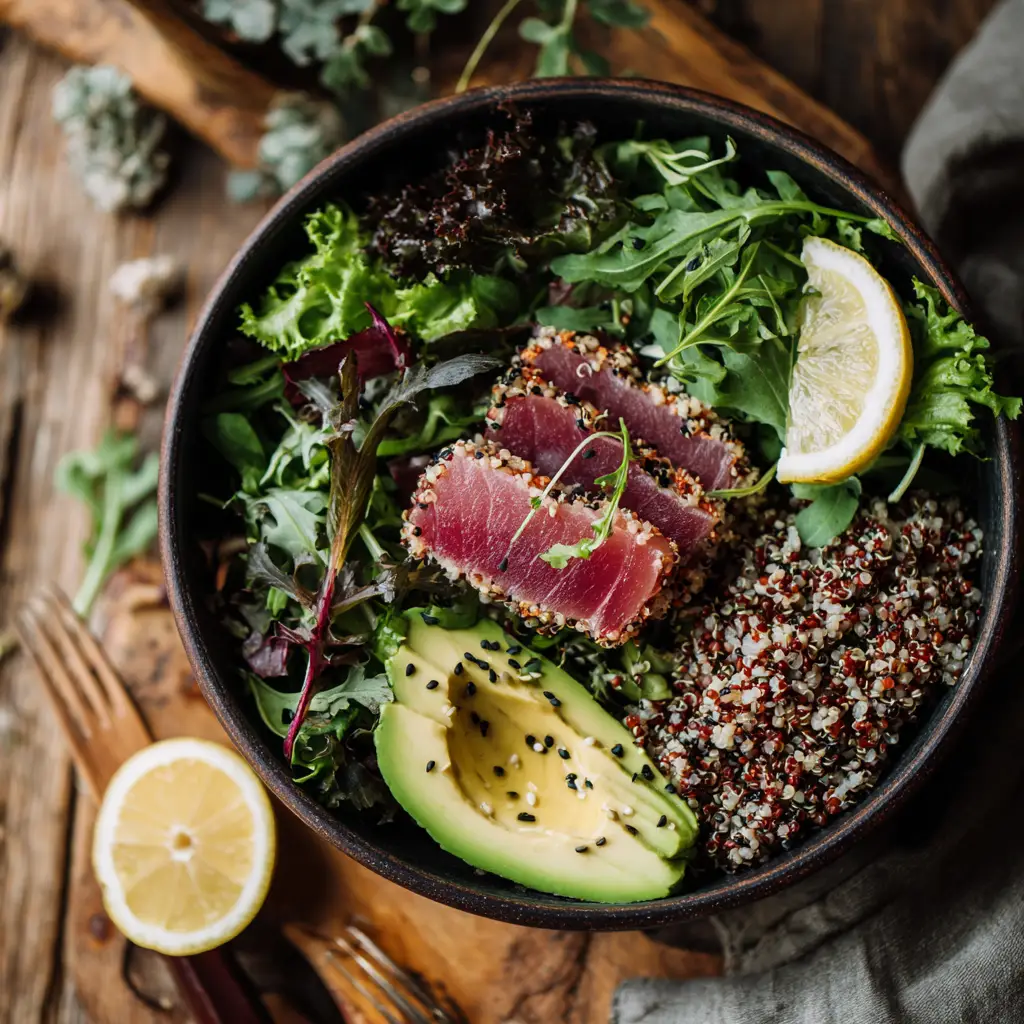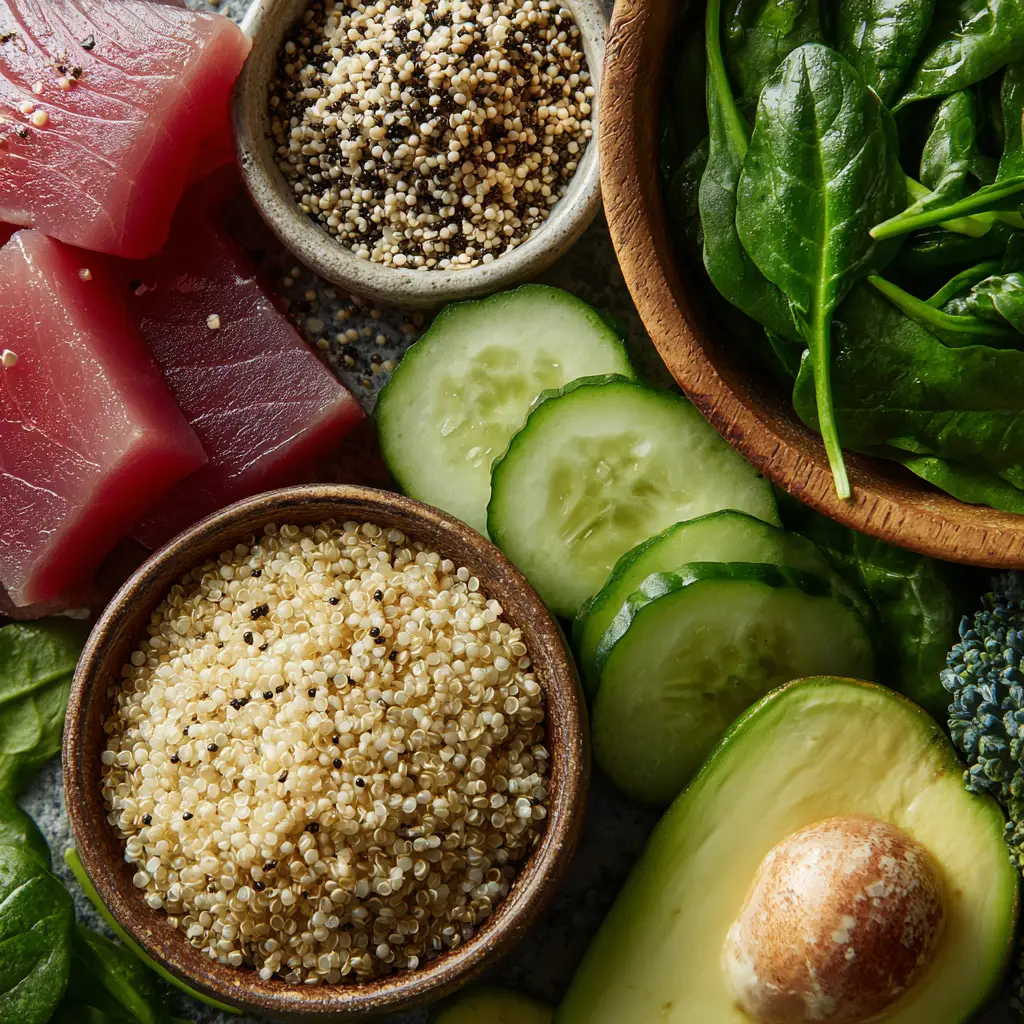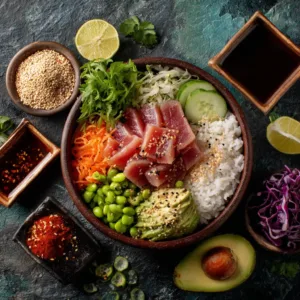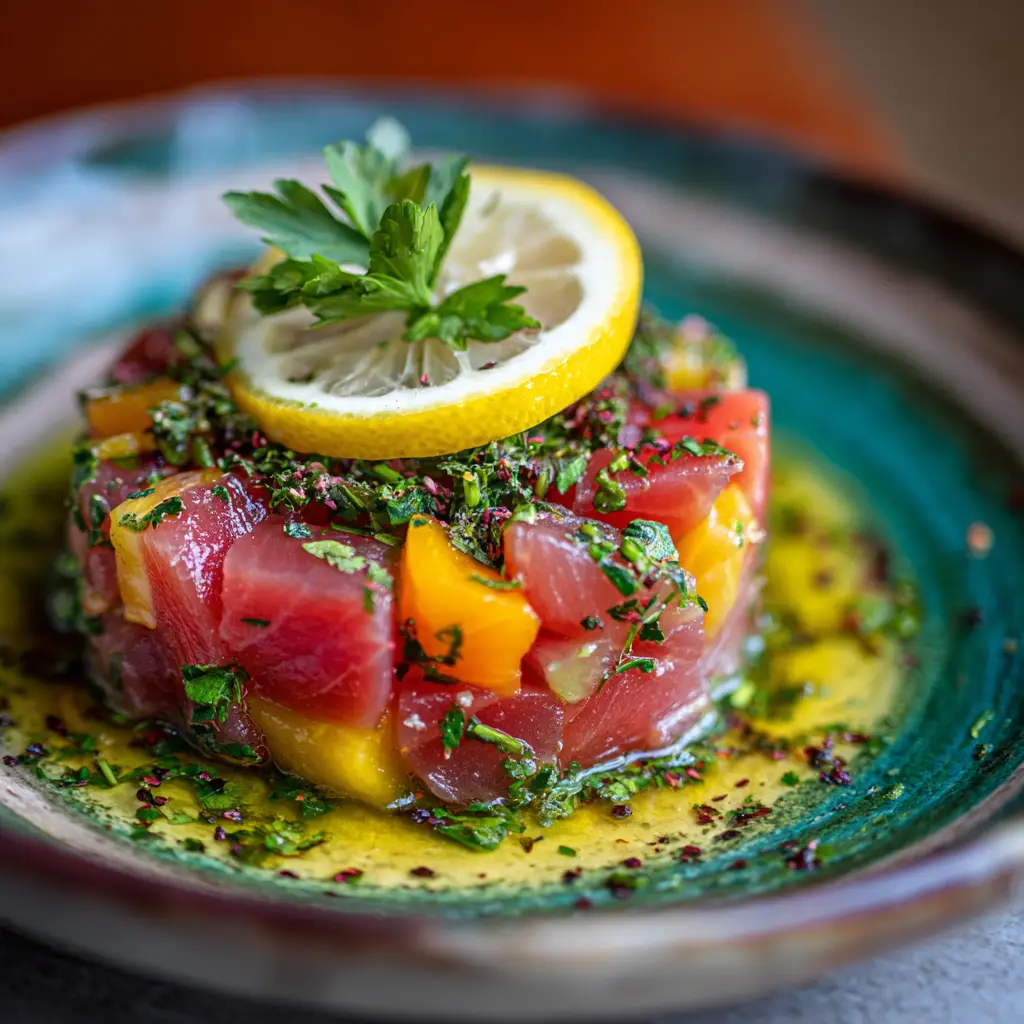Looking for a protein-packed food that won’t sabotage your calorie goals? Tuna fish and weight loss often go hand in hand—and for good reason. With its lean profile, low calorie count, and muscle-preserving protein, tuna shows up again and again in diet plans across the U.S. But is it all it’s cracked up to be?
In this article, you’ll discover how tuna fish and weight loss really connect: the benefits that make it a go-to in so many healthy eating plans, the potential risks you should know (yep, we’re talking mercury), and smart ways to make tuna part of your weekly routine. You’ll also get simple meal ideas, real comparisons with other proteins like chicken or eggs, and honest answers to questions like “Is canned tuna good for losing weight?”
Looking for more weight-friendly favorites? Don’t miss our guide to guilt-free comfort food — where cozy meets clean.
Why Tuna Is a Popular Choice in Weight Loss Plans
High-Protein, Low-Calorie Champion
I still remember the first time I built a weight loss meal plan around tuna. It was a hectic Monday, and I needed something quick, filling, and not boring. I opened a can of tuna, added lemon juice, diced celery, and a dollop of Greek yogurt—boom, lunch prepped for three days.
That week? I lost two pounds—and felt full every afternoon.
That’s what makes tuna fish and weight loss such a powerful combo. At just about 100 calories per 3-ounce serving, with over 20 grams of protein, tuna is one of the easiest ways to stay in a calorie deficit without constant hunger. The high protein keeps you satisfied, and it helps protect muscle mass—which is key to burning fat efficiently.
Whether you’re trying intermittent fasting or simply eating cleaner, canned tuna for weight loss is practical and budget-friendly. It’s also a fantastic option for high-protein snacks—try it with sliced cucumbers, in lettuce wraps, or mixed with avocado for a creamy texture without the extra calories.
And if you’re a fan of healthy comfort meals, pair a tuna-stuffed baked sweet potato with our low-calorie mac and cheese for a weeknight dinner that won’t derail your goals.

Nutrient Bonus — Omega‑3s, Vitamins & Minerals
Beyond protein, tuna is a quiet powerhouse when it comes to nutritional density. It delivers omega-3 fatty acids, which can help with inflammation, brain health, and even fat metabolism—all important if you’re focused on long-term weight loss.
You’ll also get essential nutrients like:
- Vitamin D – supports hormone balance and immunity
- B12 and B6 – boost energy and metabolism
- Selenium – an antioxidant that supports thyroid function
- Iron and phosphorus – critical for energy levels and bone health
These aren’t just bonus points. They support the systems that help your body burn fat efficiently, making tuna more than just a lean protein—it’s a smart part of a balanced weight loss strategy.
Want a warm, cozy meal that uses tuna in a totally unexpected way? Try it in our healthy buffalo chicken dip—just sub the chicken with tuna. It’s fast, low-calorie, and shockingly good.
Different types of tuna also have different profiles. For example:
| Tuna Type | Calories (3 oz) | Protein | Mercury Level | Fat Content |
|---|---|---|---|---|
| Skipjack (Light) | ~100 | 20g | Low | ~0.5g |
| Albacore (White) | ~110 | 22g | Moderate–High | ~1.5g |
| Fresh Ahi Tuna | ~115 | 23g | Low–Moderate | ~2g |
Skipjack is typically lower in mercury and a better choice if you’re eating tuna often for weight loss.
The Catch — Risks, Mercury & Common Pitfalls
Mercury in Tuna: How Much Is Too Much?
Let’s be honest—tuna fish and weight loss might seem like a dream combo, but not every kind of tuna is created equal. One of the most important things to watch out for when adding tuna to your weight loss diet? Mercury.
Tuna, especially larger species like albacore and yellowfin, can carry elevated levels of mercury—a heavy metal that builds up in your body over time. If you’re relying on tuna several times a week for quick meals, it’s crucial to know how to do it safely.
Here’s a quick cheat sheet to keep your meals clean:
| Tuna Type | Mercury Risk | Weekly Limit (FDA Guidance) |
|---|---|---|
| Skipjack (Light Tuna) | Low | Up to 2–3 servings/week |
| Albacore (White Tuna) | Moderate | Max 1 serving/week |
| Bigeye/Ahi Tuna | High | Not recommended |
If tuna fish and weight loss are part of your regular routine, stick to light skipjack canned in water—it’s not only lower in mercury but also affordable and easy to prep.
Balancing your meals is key. Mix in other lean protein sources and rotate recipes to stay within safe limits. Our healthy orange chicken or lightened-up burgers are great options that still support your goals.
The Tuna Diet Trap: Too Much of a Good Thing
Have you ever heard of the “tuna diet”? It’s one of those fast-track plans that promise dramatic results by focusing almost entirely on tuna and a few low-calorie add-ons. But here’s the problem: tuna fish and weight loss shouldn’t mean eliminating whole food groups.
These crash diets often lead to:
- Nutrient deficiencies
- Boredom and cravings
- Yo-yo weight gain
- Higher mercury exposure
- A poor relationship with food
A better strategy? Include tuna in balanced, whole-food meals that actually nourish your body. You can enjoy the benefits of tuna fish and weight loss without falling into unsustainable habits.
Let’s not forget—tuna fish and weight loss go well together, but only when part of a well-rounded, high-protein diet. You’ll lose fat, stay satisfied, and avoid burnout.
Still unsure about how much tuna is “safe”? The FDA recommends up to two to three servings of low-mercury tuna per week for most adults. That means tuna can absolutely play a role in your meal planning—as long as it’s not your only source of protein.
In short, tuna fish and weight loss can work beautifully—but not in isolation. Think variety, moderation, and long-term habits over quick fixes.
Smart Ways to Include Tuna in a Weight Loss Meal Plan
Balanced Plate Strategy with Tuna
The key to success with any weight loss effort isn’t just cutting calories—it’s knowing how to combine the right foods. And that’s where tuna fish and weight loss make such a strong pair.
This lean protein is a perfect foundation for a nutrient-dense meal plan, especially when combined with:
- Fiber-rich vegetables
- Healthy fats like avocado or olive oil
- Smart carbs like sweet potatoes or lentils
Together, they create a plate that’s satisfying, balanced, and supports fat loss.
Here’s a simple example of a tuna-based low-calorie meal:
| Meal Component | Example |
|---|---|
| Protein | 3–4 oz canned skipjack tuna |
| Fiber | Steamed broccoli + cherry tomatoes |
| Healthy Fat | ¼ avocado or tsp olive oil |
| Smart Carb | ½ cup quinoa or lentils |
This kind of structure proves that tuna fish and weight loss don’t require boring, restrictive meals. They’re about eating smarter, not less.
If you’re short on time, canned tuna for weight loss is an ideal option—it’s shelf-stable, pre-cooked, and works beautifully for meal prep. Try tossing it into your favorite salad or using it as a protein-packed base for a wrap.
Looking for variety? You can even use tuna as a swap in our healthy lasagna recipe. It’s a creative, flavorful way to cut down on saturated fat and increase protein intake.
These kinds of high-protein swaps reinforce the link between tuna fish and weight loss in a real-life, sustainable way. You’re not stuck eating bland food—you’re just making smarter choices.
Craving something even simpler? Our homemade mounjaro-inspired recipe follows a similar macro-friendly formula and shows how protein-based meals can transform the way you eat.
Easy, Low-Calorie Tuna Recipes & Snack Ideas
Adding variety is key if you want to stick with any routine. That’s why tuna fish and weight loss work best when tuna becomes a go-to ingredient, not the entire plan.
Here are a few Ivy-approved recipes and snack ideas:
- Tuna Egg Scramble – Sauté spinach, onions, and tuna in olive oil, then crack in two eggs.
- Lettuce-Wrapped Tuna Salad – Crunchy, satisfying, and low in carbs.
- Mediterranean Tuna Bowl – Fresh veggies, olives, lemon dressing.
- Tuna & Chickpea Mash – Rich in fiber and surprisingly filling.
- Greek Yogurt Tuna Dip – High-protein, creamy, and perfect with cucumber slices.
These snack options support fat loss because they deliver protein without the bloat. They show that tuna fish and weight loss can be fun, flavorful, and fast.
Still wondering is tuna good for you? Yes—especially when you pair it with real, colorful foods and keep portions moderate.
Want a cozy side that pairs well with a tuna melt? Our healthy mushroom soup is creamy without the cream—and keeps your macros on track.
With the right balance, tuna fish and weight loss become a practical lifestyle—not just a short-term fix.
Protein-Packed Tuna Bowl for Weight Loss


Protein-Packed Tuna Bowl for Weight Loss
Equipment
- serving bowl
- cutting board
- knife
- spoon or fork
Ingredients
- 1 can light tuna in water (drained)
- 0.5 cup cooked quinoa or brown rice
- 0.5 avocado, sliced
- 1 cup baby spinach or mixed greens
- 0.5 cup diced cucumber
- 0.25 cup shredded carrots
- 1 tbsp olive oil
- 0.5 lemon, juiced
- salt and pepper to taste
- pinch of chili flakes or fresh herbs (parsley, cilantro) (optional)
Instructions
- In a bowl, layer the spinach or greens as a base.
- Top with cooked quinoa, tuna, cucumber, carrots, and avocado.
- Drizzle with olive oil and lemon juice.
- Sprinkle with salt, pepper, and chili flakes if using.

- Toss lightly before eating, or keep layered for a lunch prep bowl.
Notes
Nutrition
Comparing Tuna with Chicken, Eggs & Other Proteins
Is Tuna or Chicken Better for Weight Loss?
When comparing tuna fish and weight loss to chicken, it really depends on what your body needs and how you eat.
Tuna is naturally lower in fat, especially saturated fat, and provides a clean, lean protein source with fewer calories. Chicken, especially skinless breast, also offers plenty of protein, but it can have slightly more calories per serving and is often cooked with oils or sauces that add extra fat.
That said, chicken tends to be more versatile in flavor and texture. Many people find it easier to incorporate into their weekly meal plans without getting bored. Tuna wins for portability and convenience, especially when using canned tuna in water.
The best approach? Don’t pick one over the other. Combining both tuna and chicken in a balanced weight loss plan gives you variety and makes it easier to stick with your goals long-term. If you want creative ways to mix both, don’t miss our low-calorie mac and cheese made with tuna or grilled chicken for a cozy, protein-packed dinner.
So yes—tuna fish and weight loss work, but not in a vacuum. It’s about variety and long-term strategies, not just a single food.
What About Eggs vs Tuna?
Eggs are rich in nutrients like choline and vitamin A, and they bring healthy fats that tuna doesn’t. However, when it comes to pure lean protein, tuna delivers more with fewer calories.
Tuna has more B-vitamins, less saturated fat, and zero carbs, making it ideal for anyone watching their calorie intake or aiming for high-protein, low-fat meals.
Still, eggs play a vital role in a healthy diet and pair beautifully with tuna. A tuna egg scramble or salad with hard-boiled eggs can give you the best of both worlds.
When used together thoughtfully, tuna fish and weight loss can go hand in hand with other whole-food proteins. Want more cozy recipes that mix clean proteins? Check out our healthy buffalo chicken dip for a creative way to switch things up.
FAQs: Your Top Questions Answered
Is canned tuna good for losing weight?
Yes—canned tuna for weight loss works well when you choose skipjack or light tuna in water. It’s low in calories, high in protein, and easy to prepare. It’s one of the most convenient ways to support tuna fish and weight loss goals on a tight schedule.
Is chicken or tuna better for weight loss?
Tuna is leaner and lower in calories, while chicken offers more flexibility and flavor options. Mixing both is the best strategy.
What’s healthier, eggs or tuna?
Both have benefits. Tuna is better for lean protein, while eggs bring healthy fats and extra nutrients. Together, they work great in a varied diet.
Does tuna speed up your metabolism?
Tuna supports metabolism by helping preserve lean muscle through its high protein content and by providing omega-3 fatty acids that may improve metabolic function. Many people who prioritize tuna fish and weight loss also report better energy and recovery.
How often can you eat tuna safely?
Two to three servings of light tuna per week are generally safe for most adults. Albacore or larger species should be limited to once weekly due to mercury concerns.
Which type of tuna is safest for weight loss?
Skipjack or light canned tuna has the lowest mercury levels and fits well into a clean eating plan focused on tuna fish and weight loss. To complement this, see how our boiled pierogies weight loss recipe makes a surprising low-calorie side that works with lean proteins like tuna.
Trusted Insights Backing Tuna and Weight Loss Benefits
For anyone serious about sustainable fat loss, tuna fish and weight loss can absolutely go hand in hand—when used in moderation and paired with real, nourishing foods. But don’t just take our word for it. According to the National Institutes of Health, incorporating lean proteins like tuna can help preserve muscle mass while cutting calories—a key to long-term fat loss. The Harvard T.H. Chan School of Public Health also highlights fish like tuna as valuable sources of omega-3 fatty acids, which support heart health and metabolic function. And if you’re wondering about safety and nutritional value, Healthline confirms that canned tuna—especially light varieties—is high in protein and generally safe when consumed in moderation.
The takeaway? Whether you’re prepping for the week, managing your macros, or aiming to feel your best, tuna remains one of the most accessible, affordable, and evidence-backed foods to support your health goals.
Conclusion & Take‑Home Tips
Tuna fish and weight loss are a strong combination—when you follow a balanced, realistic approach.
Tuna offers lean protein, essential nutrients like selenium and B-vitamins, and omega-3 fats that support overall health. It’s ideal for quick meals and snacks when you’re watching calories.
Just remember: it’s not about eating only tuna. You need variety, fiber, healthy fats, and moderation.
Incorporate tuna into 2–3 meals per week, pair it with colorful vegetables, whole grains, and rotate with other proteins like eggs and chicken. This way, you can enjoy all the benefits of tuna while building a meal plan you can actually stick to.
Weight loss isn’t about extremes—it’s about consistency. Tuna just happens to be one of the smartest ingredients to help you stay on track.


